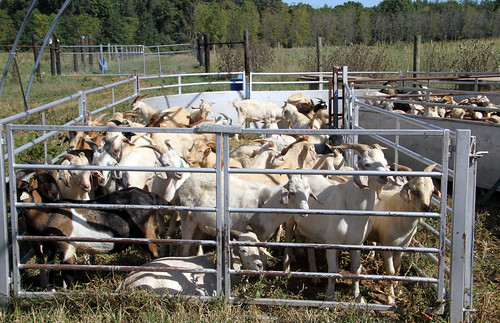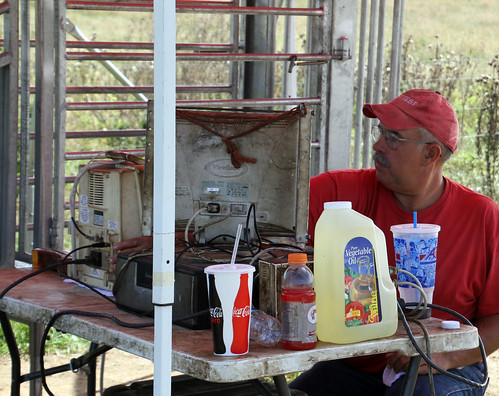The bucks were scanned last Thursday, September 24 by Jim Pritchard (West Virginia). The data was processed at the Iowa Centralized Ultrasound Processing Center (CUP Lab).
For the 84 bucks in the test, rib eye area ranged from 0.53 to 1.53 square inches and averaged 1.07 + 0.19 square inches. The median rib eye area was 1.06 square inches. The buck with the largest rib eye was 537 (Loyd, NC).
As there wasn't much difference in the average rib eye areas of the different weight groups, ratios were calculated from the average rib eye area (1.07), meaning a buck with a rib eye measurement of 1.20 has a rib eye ratio of 112% (1.20 ÷ 1.07).
Loin depth ranged from 0.40 to 0.92 inches and averaged 0.69 + 0.9 inches. The median loin depth was 0.68 inches. The buck that scanned with the deepest loin was 542 (Majancsik, KY). In other countries, loin depth is the preferred measurement of carcass muscling.
Rib fat varied from 0.02 to 0.06 and averaged 0.04 + 0.01 inches. The median rib fat was 0.04 inches. From a carcass standpoint, bucks in the test have not ever had measurable back fat. Even body wall thickness has been difficult to measure. Internal (kidney and heart) fat is the primary measure of carcass fat in a goat. Unfortunately, it cannot be estimated using ultrasound technology.
Past data suggests a correlation between ultrasound measurements and carcass measurements (of rib eye area). Comparisons between bucks are probably more valid than actual measurements. For example: a buck that scans with a 1.2 square inch rib eye area may not have exactly a 1.2 square inch rib eye, but his rib eye will be larger than a buck that scans with a 0.90 square inch rib eye.
Download ultrasound report
For the 84 bucks in the test, rib eye area ranged from 0.53 to 1.53 square inches and averaged 1.07 + 0.19 square inches. The median rib eye area was 1.06 square inches. The buck with the largest rib eye was 537 (Loyd, NC).
 |
| Scanning day |
As there wasn't much difference in the average rib eye areas of the different weight groups, ratios were calculated from the average rib eye area (1.07), meaning a buck with a rib eye measurement of 1.20 has a rib eye ratio of 112% (1.20 ÷ 1.07).
Loin depth ranged from 0.40 to 0.92 inches and averaged 0.69 + 0.9 inches. The median loin depth was 0.68 inches. The buck that scanned with the deepest loin was 542 (Majancsik, KY). In other countries, loin depth is the preferred measurement of carcass muscling.
Rib fat varied from 0.02 to 0.06 and averaged 0.04 + 0.01 inches. The median rib fat was 0.04 inches. From a carcass standpoint, bucks in the test have not ever had measurable back fat. Even body wall thickness has been difficult to measure. Internal (kidney and heart) fat is the primary measure of carcass fat in a goat. Unfortunately, it cannot be estimated using ultrasound technology.
 |
| Jim Pritchard |
Past data suggests a correlation between ultrasound measurements and carcass measurements (of rib eye area). Comparisons between bucks are probably more valid than actual measurements. For example: a buck that scans with a 1.2 square inch rib eye area may not have exactly a 1.2 square inch rib eye, but his rib eye will be larger than a buck that scans with a 0.90 square inch rib eye.
Download ultrasound report











